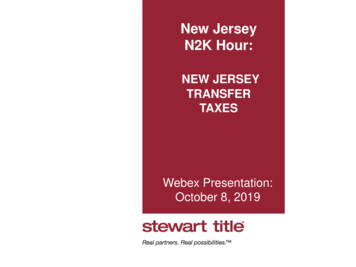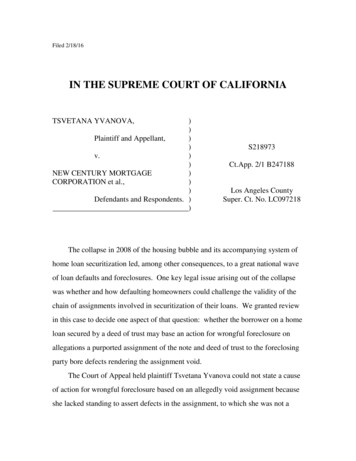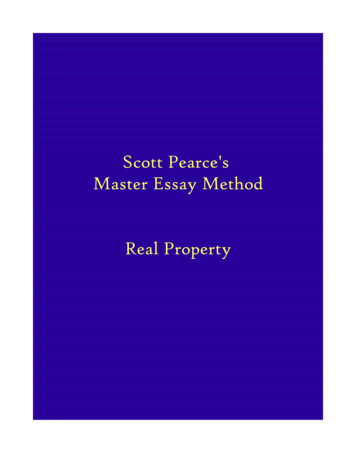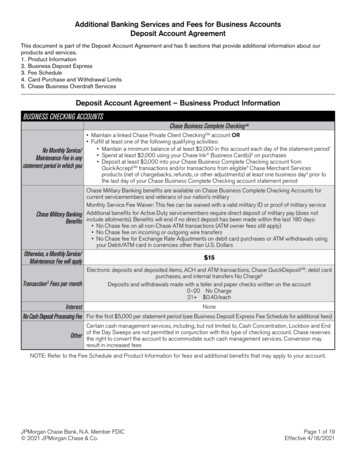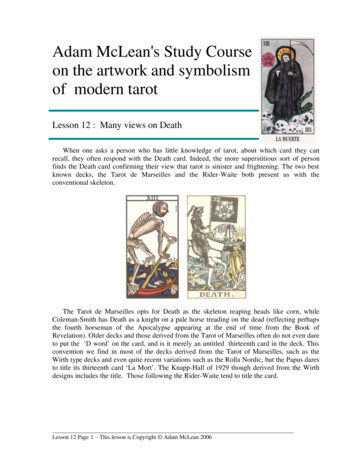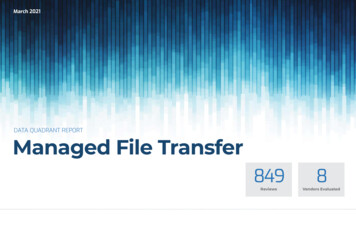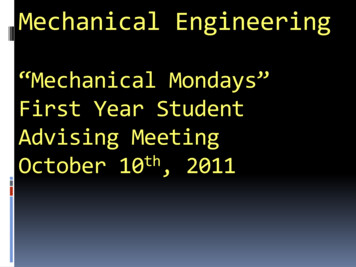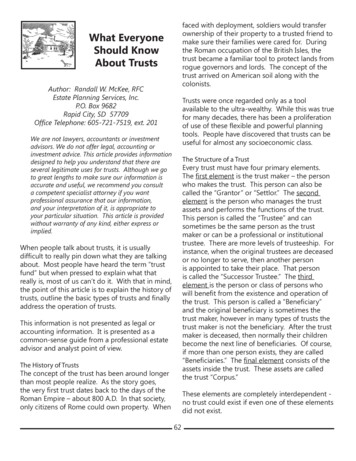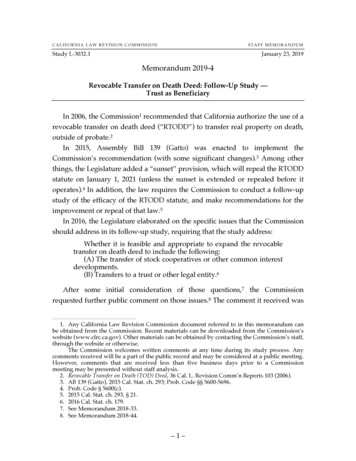
Transcription
CALIFORNIA LAW REVISION COMMISSIONSTAFF MEMORANDUMStudy L-3032.1January 23, 2019Memorandum 2019-4Revocable Transfer on Death Deed: Follow-Up Study —Trust as BeneficiaryIn 2006, the Commission1 recommended that California authorize the use of arevocable transfer on death deed (“RTODD”) to transfer real property on death,outside of probate.2In 2015, Assembly Bill 139 (Gatto) was enacted to implement theCommission’s recommendation (with some significant changes).3 Among otherthings, the Legislature added a “sunset” provision, which will repeal the RTODDstatute on January 1, 2021 (unless the sunset is extended or repealed before itoperates).4 In addition, the law requires the Commission to conduct a follow-upstudy of the efficacy of the RTODD statute, and make recommendations for theimprovement or repeal of that law.5In 2016, the Legislature elaborated on the specific issues that the Commissionshould address in its follow-up study, requiring that the study address:Whether it is feasible and appropriate to expand the revocabletransfer on death deed to include the following:(A) The transfer of stock cooperatives or other common interestdevelopments.(B) Transfers to a trust or other legal entity.6After some initial consideration of those questions,7 the Commissionrequested further public comment on those issues.8 The comment it received was1. Any California Law Revision Commission document referred to in this memorandum canbe obtained from the Commission. Recent materials can be downloaded from the Commission’swebsite (www.clrc.ca.gov). Other materials can be obtained by contacting the Commission’s staff,through the website or otherwise.The Commission welcomes written comments at any time during its study process. Anycomments received will be a part of the public record and may be considered at a public meeting.However, comments that are received less than five business days prior to a Commissionmeeting may be presented without staff analysis.2. Revocable Transfer on Death (TOD) Deed, 36 Cal. L. Revision Comm’n Reports 103 (2006).3. AB 139 (Gatto), 2015 Cal. Stat. ch. 293; Prob. Code §§ 5600-5696.4. Prob. Code § 5600(c).5. 2015 Cal. Stat. ch. 293, § 21.6. 2016 Cal. Stat. ch. 179.7. See Memorandum 2018-33.8. See Memorandum 2018-44.–1–
considered in Memorandum 2018-58 and its First and Second Supplements. TheCommission made a number of provisional decisions based on that input, but“postponed making a decision on whether an RTODD should be able to transferproperty to a trust.”9This memorandum revisits the postponed question about trusts asbeneficiaries of an RTODD. The public comments that bear on that question havebeen attached to this memorandum for convenience of reference. They areincluded in the Exhibit as follows: Exhibit p.Mark S. Poochigian, Trusts and Estates Section ExecutiveCommittee, State Bar of California (6/1/2017) . 1Angela Petrusha, Eureka (6/20/18) . 11Craig Page, California Land Title Association (8/16/18) . 14Mason L. Brawley, Trusts and Estates Section ExecutiveCommittee, California Lawyers Association (11/20/2018) . 20Nina Whitehurst, Montague (12/4/18) . 24Nina Whitehurst, Montague (12/17/18) . 26The letters from the Trusts and Estates Section Executive Committee(“TEXCOM”) and the California Land Title Association (“CLTA”) address anumber of issues besides naming a trust as beneficiary. The trust-related parts ofthose letters can be found at Exhibit pages 3-4, 16-17, and 21-22. The letters fromMs. Petrusha and Ms. Whitehurst are entirely relevant to the trust issue.Note: In conducting this study, the Commission will examine a number ofspecific ways in which the law might be improved. The fact that the Commissionis considering those specific issues does not mean that the Commission hasreached a decision on the general question of whether the RTODD statute shouldbe repealed or continue in effect. It has not done so.SUPPORT FOR ALLOWING TRUSTS TO BE NAMED AS BENEFICIARIESMs. Petrusha and Ms. Whitehurst, both estate planning attorneys, write insupport of allowing the RTODD to be used to transfer property to a trust.Ms. Petrusha notes that she had a client who wished to use an RTODD totransfer property to a trust. She explains why a person might wish to take thatapproach, rather than simply transferring title to the trust during life:9. Minutes (Dec. 2018), pp. 7-8.–2–
Some have questioned the necessity of naming a trust asbeneficiary of an RTODD rather than transferring the subjectproperty to a revocable living trust, which would also avoidprobate. While this may be the solution in most cases, sometimesthis is not a viable option. For example, consider the homeownerwho does not wish to incur the expense of creating a trust forherself, but wishes to name a supplemental needs trust (or "SpecialNeeds Trust") as beneficiary of her home. A Special Needs Trust istypically created for the benefit of a person with a disability whowould encounter negative consequences if he or she receivedproperty or money outright. The homeowner has a modest estatethat would not otherwise require a formal probate. In keeping withthe intent of AB 139, shouldn't this homeowner be allowed astraightforward, inexpensive, non-probate option for transferringthis asset upon death?10Ms. Whitehurst offers a different scenario in which it would make sense touse an RTODD to transfer title to a trust on death, rather than transferring titleduring life:Too many times I have seen individuals place their home intotheir revocable living trust only to be forced by a refinance lenderto deed it back out again. (Many lenders think they cannot lend to a“trust”. They are mistaken in that regard, but that is not the issuebefore us. The fact is it happens, a lot.) Then the borrower forgets todeed the property back into his or her or their trust after therefinance transaction is concluded. The results are time-consumingand expensive probate, frustration of the intended plan ofdistribution, and money wasted on estate planning that was notput to use because the main asset wasn’t in the trust at death.Although keeping the home in the trust at all times is the ideal,and second best is remembering to deed it back after everyrefinance, I would like to be able to recommend to clients that ifthey think there are one or more home loan refinancings in theirfuture, they might want to just name their revocable living trust asthe death beneficiary pursuant to a RTODD.11She adds:It would be nice if homeowners in California could retain title intheir individual names during lifetime to facilitate residentialacquisitions and refinancings but be able to sleep at night knowingthat when they pass their trust will be funded with said real estateand not get tied up in lengthy, expensive and public probateproceedings.1210. See Exhibit p. 12.11. Id. at 24.12. Id. at 27.–3–
The Commission has not received any comment suggesting that it would beinappropriate, as a policy matter, to allow a trust to be named as beneficiary of anRTODD. The same result (post-death transfer of property to a trust) is routinelyachieved with a will (although that would generally require probateadministration).Ms. Petrusha and Ms. Whitehurst offer concrete examples of situations wherenaming a trust as beneficiary of an RTODD would be beneficial.CONCERNS ABOUT ALLOWING TRUSTS TO BE NAMED AS BENEFICIARIESBoth TEXCOM and CLTA maintain that the law should not permit anRTODD to be used to transfer property to a trust.TEXCOM believes that allowing a trust to be named as beneficiary of anRTODD would lead to confusion and error:In TEXCOM's view, allowing for transferors to name trusts andlegal entities as beneficiaries of RTODDs invites confusion anderrors by unknowing transferors; thus, the better rule would be toprovide that only individuals may be named as beneficiaries inRTODDs.13CLTA is concerned that allowing a trust to be named as beneficiary of anRTODD could create opportunity for fraud:Trustee of a trust: Testamentary trusts are governed throughprobate courts. Allowing a trustee of a trust to be named abeneficiary only allows opportunity for fraud under the pretense offormality and creates a potential conflict with well-establishedexisting law. [W]e have serious reservations over the expansion of RTODDsto include legal entities as beneficiaries, and strongly believe that –were such an expansion to take place – the trustee of a trustcontinue to be excluded.14The risks of confusion and fraud are discussed separately below.Before beginning that discussion, it is worth considering a general pointmade by Ms. Whitehurst:13. See Exhibit p. 4. See also Exhibit p. 21 (“TEXCOM believes that the option of naming a trustas beneficiary invites confusion and has urged the Commission to foreclose the possibility ofnaming a trust as the beneficiary of an RTODD. “).14. See Exhibit p. 16.–4–
At some point, there has to be a limit to how far the state shouldgo in protecting people from their poor choices. Don’t be soprotective of the least common denominator that you eliminatehuge benefits for the vast majority of candidates for this type ofplanning.15It is worth noting that California does not prohibit people drafting their ownwills, despite the likelihood that some self-help drafters will make mistakes thatcould defeat their intentions (including the possibility that execution errors couldinvalidate the entire instrument). Nor does California preclude self-drafted trustsor grant deeds.ConfusionTEXCOM has not provided a specific explanation of why allowing atransferor to name a trust as beneficiary of an RTODD would increase the risk ofconfusion and error. The staff invites further explanation on that point.The staff does see one potential source of confusion — ambiguity as to theidentity of a trust that is named as a beneficiary.When naming a natural person as beneficiary of an RTODD, the mandatorystatutory form requires that the transferor provide “the FULL NAME(S) of theperson(s) who will receive the property on your death (DO NOT use generalterms like “my children”) and state the RELATIONSHIP that each named personhas to you (spouse, son, daughter, friend, etc.).”16 That requirement shouldprovide enough information to correctly identify a natural person who is namedas a beneficiary.But how would one identify a trust with enough specificity to avoid anyuncertainty as to the identity of the trust? A good starting point would be torequire that the trust be named, using the name that was given to the trust in thetrust document itself.The staff sees two potential complications with that approach. First, theredoes not seem to be any legal requirement that a trust be given a name. So it istheoretically possible that a trust could be unnamed. However, every sampletrust that the staff found online or in legal practice treatises called for the trust tobe named.17 It seems likely that the naming of trusts is a routine practice, even15. Id. at 25.16. Prob. Code § 5642(a).17. See, e.g., M. Stern, Drafting California Revocable Trusts, Appendices A-D, at 757, 799, 832,858 (Cal. Cont. Ed. Bar 4th Ed.); redliving-trust.html ; cable-living-trust-–5–
for laypeople using forms. So it is not clear that this would be more than atheoretical problem.Second, the name of a trust may not be sufficiently distinct to differentiate itfrom other trusts. For example, there are probably thousands of trusts named“the Jones Family Trust” in California. How would it be possible to know withcertainty which “Jones Family Trust” has been named as beneficiary of anRTODD?In many situations, common sense would make the answer obvious. But thatdegree of certainty is not sufficient for the operation of an RTODD. Because itoperates without court involvement, the RTODD statute depends on title recordsand title insurance as away of effectuating the transfer of title. The effect andvalidity of an RTODD must be determinable from title records, without the needfor any inquiry outside of those records. If the record contains any materialambiguity, title insurers will be reluctant to insure that the beneficiary has goodtitle. That would make it difficult or impossible for the beneficiary to sell orencumber the transferred property. The beneficiary would probably need to goto court to establish clear title.The staff sees two ways to minimize or eliminate any uncertainty as to theidentity of a trust that is named as the beneficiary of an RTODD.The first possibility would be to require that the date of execution of the trustalso be provided, along with the name of the trust (e.g., “Jones Family Trust,executed on January 1, 2020”). The biggest downside of that approach would bethe risk of a technical error. If a transferor provides the wrong date, the errorcould raise doubts about the validity of the RTODD and its intended effect.A second possibility would be to require that a copy of the trust document berecorded along with the RTODD. This approach should eliminate anyuncertainty as to the identity of the trust that is being named as beneficiary.Again, the biggest downside would be the risk of a technical error. If a transferordoes not realize that the trust must be recorded, and fails to do so, the RTODDcould wind up in the courts and could be invalidated. Trust documents can belengthy and it is possible that a transferor could accidently omit a page or notrealize that the notary’s acknowledgement should be included (if that were arequirement).form/ ;form/ . alifornia-revocable-living-trust-–6–
Those kinds of practical problems could probably be worked out. If theCommission would like to pursue either or both options (i.e., require that theRTODD specify the date of execution of a trust named as beneficiary and/orrequire recordation of the trust document), the staff will bring the issue back in afuture memorandum, with a fuller analysis and range of options. If theCommission decides to take that approach, the staff would welcomesuggestions from stakeholders on how to unambiguously identify a trust, anissue that must come up regularly in estate planning.FraudCLTA expresses concern about fraud, but does not provide specific detailabout how naming a trust as beneficiary of an RTODD would create anyadditional or special risk of fraud.One possible explanation might be found by looking closely at the languagethat CLTA used in its letter. CLTA writes (with bold added for emphasis):Trustee of a trust: Testamentary trusts are governed throughprobate courts. Allowing a trustee of a trust to be named abeneficiary only allows opportunity for fraud under the pretense offormality and creates a potential conflict with well-establishedexisting law. [W]e have serious reservations over the expansion of RTODDsto include legal entities as beneficiaries, and strongly believe that –were such an expansion to take place – the trustee of a trustcontinue to be excluded.18CLTA consistently refers to the naming of a “trustee of a trust” as thebeneficiary of an RTODD. That is reasonable. Under the existing UniformTestamentary Additions to Trusts Act, a “pour-over” will may devise property to“the trustee of a trust.”19 Property devised in that way “becomes a part of thetrust to which it is given” on the testator’s death.20 So, it appears to be anestablished practice to name the trustee of a trust as devisee, when devisingproperty to a trust.This suggests that some transferors would do the same with an RTODD,naming the trustee of a trust as beneficiary when intending to transfer propertyto the trust as an entity.18. See Exhibit p. 16.19. Prob. Code § 6300(a).20. Prob. Code § 6300(b).–7–
That approach could perhaps create an opening for fraud when the transferoris a layperson. If a transferor wishes to name a trust as beneficiary, the trustee ofthat trust could perhaps trick the transferor into naming the trustee as anindividual, rather than in the trustee’s capacity as trustee. The result could be anunintended gift to the trustee personally.That strikes the staff as a very indirect way to perpetrate fraud. It would alsorequire an unusual set of circumstances — the bad actor would need to be thetrustee of a trust that the transferor wishes to name as beneficiary. As the staffhas noted before, there are much more direct and immediately effective ways tocommit elder financial abuse.That said, if the staff is understanding CLTA’s concern correctly, it might bepossible to address the problem by expressly precluding (and warning against)naming a trustee as beneficiary, rather than naming the trust itself.If the staff is not understanding the issue, we would appreciate getting afuller explanation from CLTA of their concern.CONCLUSIONAs discussed above, there seem to be good reasons to allow the use of anRTODD to transfer property to a trust. For example: An RTODD could be used to provide a revocable way to transferreal property to an irrevocable trust (such as a special needs trust),on the transferor’s death. This would give the transferor thegreatest degree of control of the property during the transferor’slife, while also allowing the at-death transfer to occur withoutprobate administration.An RTODD could be used to avoid the problem that Ms.Whitehurst describes: A person sets up a revocable living trust andtransfers real property to the trust. Later, when refinancing theproperty, the lender requires that the property be deeded back outof the trust. The owner then forgets to reconvey the property backto the trust, after the loan is approved. An RTODD could be usedas a back-stop in that situation, insuring that real property will betransferred to a trust on the transferor’s death, in the event that theproperty was inadvertently left out of the trust during life.However, there are practical problems that could arise if the law were topermit a trust to be named as beneficiary of an RTODD:–8–
It is theoretically possible that a trust could be unnamed, whichmight make it difficult to clearly designate the trust as beneficiaryof an RTODD.The trust could have a relatively common name, which mightundermine certainty as to which of the trusts that share the nameis being designated as beneficiary of an RTODD.If a transferor names the trustee of a trust, rather than the trustitself, there could be uncertainty about whether the transferorintended a gift to the trustee as an individual, or to the trustee asan agent of the trust. That could create scope for fraud or error.With all of the above in mind, the Commission needs to decide whether thelaw should permit a trust to be named as a beneficiary of an RTODD. If so, theCommission should also consider whether to pursue any of the followingmeasures to reduce the risks of confusion, error, and fraud: Require that a trust be named, using the name that it was given inthe trust documents.Preclude naming a trustee (as opposed to a trust) as beneficiary.Require that the date of execution of a trust be included whennaming a trust as beneficiary of an RTODD.Require that part or all of the trust document be recorded alongwith an RTODD, when naming a trust as beneficiary.How would the Commission like to proceed?Respectfully submitted,Brian HebertExecutive Director–9–
TRUSTS & ESTATES SECTIONTHE STATE BAR OF CALIFORNIAJune 1, 2017VIA E-MAILAND U.S. MAILMr. Brian HebertCalifornia Law Revision Commissionc/o UC Davis School of Law400 Mrak Hall DriveDavis, California 95616E-mail: bhebert@clrc.ca.govRe:Comments from TEXCOMStudy L-3032.1 (Revocable Transfer on Death Deed: Follow-Up Study)Dear Mr. Hebert:Thank you for soliciting comments from the Executive Committee of the Trusts andEstates Section of the State Bar of California ("TEX COM") regarding California's revocabletransfer on death deed ("RTODD") law enacted in Assembly Bill 139 of2015 (Stats. 2015, ch.293). TEXCOM appreciates the Commission's interest in TEXCOM's views regarding theRTODD law. As you know, attorneys appointed to TEXCOM have technical expertise in the areaof trusts and estates law, including planning, administration and litigation regarding nonprobatetransfers such as those made by RTODDs.As we have discussed, TEXCOM expects to relate to the Commission informationregarding experiences relating to RTODDs at some point in the next 18 months. The RTODD lawstill being quite new, TEXCOM anticipates surveying its members once some additional time haspassed in order to attempt to obtain information regarding California trusts and estates attorneys'practical experiences with RTODDs that may, in tum, be reported to the Commission. Pendingcompletion of that survey, and as we have discussed, this letter will contain TEXCOM'scomments regarding the RTODD law itself.1922463v6180 Howard Street, San Francisco, CA 94105-1639 Tel 415-538-2206EX 1 Fax 415-538-2368 http://trustslaw.calbar.ca.gov/
-2-June 1, 2017General CommentAs you know, TEXCOM has continuing concerns regarding the law providing forstatutory RTODDs. TEX COM agrees in principle with the goal of providing a mechanism bywhich persons could pass on their real property at death without the need for expensive estateplanning during lifetime or a court-supervised probate administration after death. However,TEXCOM believes that RTODDs, as enacted in Statutes of 2015, chapter 293, (i) potentiallyfacilitate the victimization of vulnerable persons by fraud, abuse and undue influence, (ii) willlead to costly litigation regarding the validity and effectiveness of RTODDs, (iii) will lead toundesirable consequences for recipients of property received by RTODD, including thepossibility of liability to creditors and the decedent's estate, and (iv) make the property that issubject of the RTODD less marketable, leading to frustration on the part of the recipients of theproperty, and the need to clear title through the legal process.TEXCOM believes the RTODD law is fundamentally flawed in a way that TEXCOMfears is not capable of being remedied. Although the statute is well-intentioned-providingowners of certain real property a means of passing that property to chosen beneficiaries at deathwithout the need to incur the expense of engaging competent legal counsel or other professionaladvisors-the practical pitfalls destroy its effectiveness. The most common drafter of a RTODDwill be the property owner himself/herself, usually drafting a deed for the very first time. Costlymistakes-some affecting the very validity of the RTODD-are inevitable. Knowledgeableattorneys will generally not recommend RTODDs because they have more appropriate tools attheir disposal.For these reasons, and some others discussed in this letter, TEXCOM believes thatconsideration should be given to repealing the RTODD law or allowing it to be automaticallyrepealed effective on January 1, 2021, pursuant to the sunset provision in California ProbateCode section 5600, subdivision (e ).1 However, TEX COM acknowledges that the Commission issupportive ofRTODDs, having recommended in Revocable Transfer on Death (TOD) Deed, 36Cal. L. Revision Comm'n Reports 103 (2006) (the "2006 Recommendation") that RTODDs beadopted in California. So, to the extent that the Commission concludes that RTODDs shouldremain authorized by California statutory law, this letter will provide TEXCOM's observationsregarding deficiencies in the law that should be reconsidered.1Unless otherwise indicated, all further statutory references are to the California Probate Code.1922463v6EX 2
-3-June 1, 2017Areas o(Specific ConcernFollowing is discussion regarding specific areas of concern that TEXCOM has identifiedregarding the RTODD law enacted in Statutes of 2015, chapter 293:1.Definition of "real property." The definition of "real property" contained inProbate Code section 561O (which limits the types of real property that are eligible to betransferred by RTODD) includes:(a)Real property improved with not less than one nor more than fourresidential dwelling units. [and]a single tract of agricultural real estate consisting of 40 acres orless that is improved with a single-family residence.(e)Thus, it appears from section 561O, subdivision (e), that agricultural property of more than 40acres was intended to be excluded from the definition of "real property." However, as long asagricultural real property (of potentially unlimited size) is improved with not less than one normore than four residential dwelling units, such real property would come within the definition of"real property" under subdivision (a).2.Time for Determining Qualification Under Definition of Real Property.Section 5614 provides that a "[r]evocable transfer on death deed" means an instrument createdpursuant to this part that . makes a donative transfer of real property to any beneficiary." Asdiscussed above, section 561O limits the type of real property that may be the subject of aRTODD to the types of real property described in that section. However, the statutes areambiguous regarding when the real property must come within the statutory definition of "realproperty." In other words, must the real property be "real property," as defined, at the time thatthe RTODD is executed? Or, at the time that the RTODD operates because of the transferor'sdeath? Suppose that a parcel of real property was improved with a residence at the time atransferor signs a RTODD with respect to the property; however, before the transferor dies, theresidence is demolished such that the property is unimproved at the time of the transferor's death.Such property would have come within the definition of "real property" at the time that theRTODD was executed, but would not come within the definition of"real property" at the timethat the RTODD operates because of the transferor's death. The intention in this regard should beclarified.3.Eligible Beneficiaries. TEXCOM is aware that Statutes of 2016, chapter179, section 1, amends Section 21 of Chapter 293 of the Statutes of2015 (the section requiringthe Commission to study the effect of California's RTODD) to require that the Commissionaddress, "[ w]hether it is feasible and appropriate to expand the revocable transfer on death deedto include . [t]ransfers to a trust or other legal entity." However, TEXCOM notes that trustsand legal entities are already authorized to be named as beneficiaries of RTODDs, without anyexpansion of the enacted statutes required. Pursuant to section 5608, the beneficiary of a RTODD1922463v6EX 3
-4-June 1, 2017may be any "person." And, in tum, section 56 defines "person" to include, "an individual,corporation, government or governmental subdivision or agency, business trust, estate, trust,partnership, limited liability company, association, or other entity." Thus, regardless of whethersuch was intended by the Legislature, trusts and legal entities are already eligible to be named asbeneficiaries in RTODDs. In TEXCOM's view, allowing for transferors to name trusts and legalentities as beneficiaries of RTODDs invites confusion and errors by unknowing transferors; thus,the better rule would be to provide that only individuals may be named as beneficiaries inRTODDs.4.Manner of Execution. Section 5624 provides as follows: "A revocabletransfer on death deed is not effective unless the transferor signs and dates the deed andacknowledges the deed before a notary public." This section is ambiguous with respect to what isactually required of the transferor in at least two respects:a.It appears that section 5624 requires that the transferor mustpersonally date the deed such that a RTODD containing a typewritten date of executionlikely would not satisfy the execution requirement contained in section 5624. This shouldbe clarified if it was contrary to the intended requirement.b.Section 5624 could be read to require that the transferor sign anddate the deed before a notary public. Generally, a document need not be signed in thepresence of the notary public; all that is required in order to obtain a notary public'sacknowledgment is that the signer personally appear before the notary public, andacknowledge having executed the document (including, for example, having executed thedocument outside of the presence of the notary public). (Civil Code§ 1189.) Theintention in this regard should be clarified.5.Timing of revocation ofRTODD. The statutes are unclear regardingwhether a revocation of a RTODD must be recorded prior to the transferor's death. On the onehand, section 5632 requires that an instrument revoking a RTODD "shall be executed andrecorded before the transferor's death" However, on the other hand, section 5628, subdivision(a), specifically authorizes revocation of a RTODD by a second, subsequent RTODD, and underthe general rule of section 5626, subdivision (a), relative to the time to record a RTODD, thesecond RTODD would be valid if recorded within 60 days of execution, even if after thetransferor's death. This matter should be clarified. The Commission should consider whether anyinstrument that would have the effect of revoking a RTODD should be required to be recordedprior to the transferor's death. In TEXCOM's view, requiring that a revocation of a RTODD berecorded prior to the transferor's death imposes a risk that transferors' desires to revoke RTODDsmay be frustrated when, for example, recordation of a RTODD before the transferor's death isimpractical ( e.g., where the transferor signs the revocation of a RTODD far away from therelevant county recorder's office), or impossible (e.g., where the transferor signs the revocationof a RTODD during a weekend when the revocation cannot be recorded until the next businessday). Sections 5632 and 5628 should be harmonized to provide that any instrument revoking aRTODD shall
property to a revocable living trust, which would also avoid probate. While this may be the solution in most cases, sometimes this is not a viable option. For example, consider the homeowner who does not wish to incur the expense of creating a trust for herself, but wishes to name
